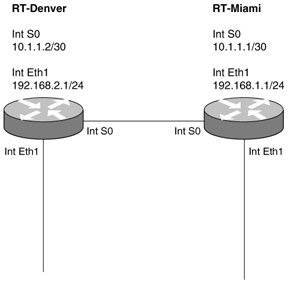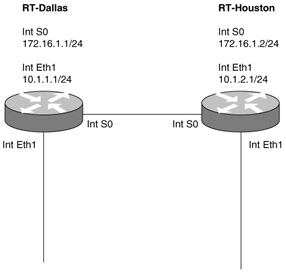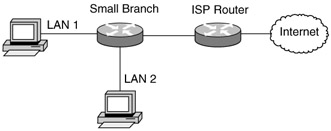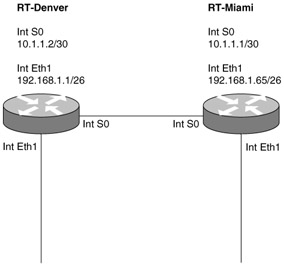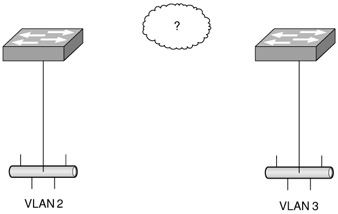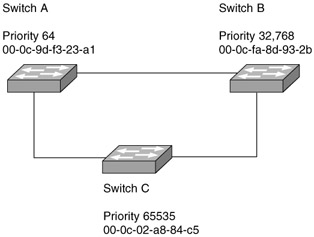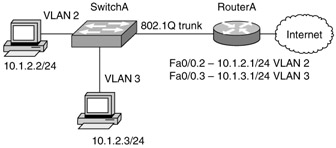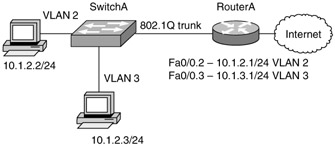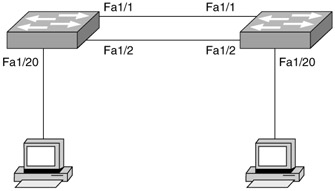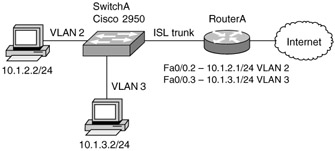CCNA-Practice Test 6
Directions: For each of the following questions, select the choice that best answers the question or completes the statement.
| 1. | Which of the following commands will display "Unauthorized access prohibited!" before the login prompt when someone initiates a Telnet session to a router?
| | |||
| 2. | What wildcard mask should be used with a network address that has a range of 172.16.16.0 through 172.16.31.0?
| | |||
| 3. | A router on one side of a PPP link uses the hostname RT-Denver and the password globalnet. Which command should be entered on RT-Denver to enable a connection between RT-Denver and another router named RT-Dallas?
| | |||
| 4. | Look at the following diagram. Assume that the RT-Houston router has already been configured with RIP. Which of the following series of commands will enable and configure RIP routing on the RT-Dallas router?
| | |||
| 5. | Which of the following are advantages of using routers in your network? (Choose three.)
| | |||
| 6. | Look at the following diagram. Suppose that all routing has already been configured using EIGRP and is working properly. Additionally, suppose that the following line has been added to RT-Miami:
IP Route 192.168.2.0 255.255.255.0 10.1.1.2 Which of the following will happen?
| | |||
| 7. | Which of the following is a benefit of segmenting your network with switches?
| | |||
| 8. | When using Frame Relay, what is the purpose of Inverse ARP?
| | |||
| 9. | You need a routing protocol that provides discontiguous network and VLSM support. It must also provide the lowest impact on router CPU and WAN utilization. Which of the following will meet these needs?
| | |||
| 10. | You are designing a WAN that will span seven sites. You must allow full-mesh communication of up to T1 speeds. Which of the following will most efficiently meet these requirements?
| | |||
| 11. | Look at the following diagram. You have been asked to prevent the Dallas LAN from accessing web services on the Houston LAN. Which wildcard should be used to describe the entire Dallas LAN 10.1.1.1/24 in the access control list?
| | |||
| 12. | Look at the following diagram. This small branch has a single /24 Internet routable network assigned, and it has been properly subnetted and assigned to the network segments. Which routing protocol is recommended to run between the branch and ISP routers?
| | |||
| 13. | Which statement describes the switch ports in a spanning-tree network that has converged?
| | |||
| 14. | Which protocol is used to resolve an IP address to an Ethernet address?
| | |||
| 15. | Look at the following diagram. When you are configuring these routers, the Miami router goes well. However, when you attempt to add the IP address to the Denver router's Ethernet 1 interface you get an error stating Bad Mask /26 for address 192.168.1.1. What is the likely cause of this problem?
| | |||
| 16. | You are at a client's site, trying to detect the source of network trouble. While using a protocol analyzer, you note the presence of BPDU frames. What is the role of BPDU frames in a network environment?
| | |||
| 17. | Which of these sentences are true regarding the following output? (Choose two.) Code Listing 6-1
04:06:16: RIP: received v1 update from 192.168.40.2 on Serial0/1 04:06:16: 192.168.50.0 in 16 hops (inaccessible) 04:06:40: RIP: sending v1 update to 255.255.255.255 via FastEthernet0/0 (192.168.30.1) 04:06:40: RIP: build update entries 04:06:40: network 192.168.20.0 metric 1 04:06:40: network 192.168.40.0 metric 1 04:06:40: network 192.168.50.0 metric 2 04:06:40: RIP: sending v1 update to 255.255.255.255 via Serial0/1 (192.168.40.1)
| | |||
| 18. | Look at the following diagram. Assume all switches are running spanning tree. Which switch will be elected root bridge?
| | |||
| 19. | Look at the following diagram. You have been asked to add configuration to the RT-Denver router preventing any hosts on the 192.168.1.0/24 network from accessing web sites on the Internet. What protocol, wildcard mask, and port should you use in the following command?
Ip access-list 151 deny [protocol] 192.168.1.0 [wildcard mask] any eq [port]
| | |||
| 20. | What is the possible problem determined from the following output? Code Listing 6-2
RouterA#sh int s0 Serial0 is up, line protocol is down
| | |||
| 21. | Look at the following diagram. What kind of device is required between the two devices to allow hosts on the two VLANs to communicate with each other?
| | |||
| 22. | How do you create a default route on a router?
| | |||
| 23. | What is the broadcast address of the subnet 192.168.99.20/30?
| | |||
| 24. | The OSPF Hello protocol performs which of the following tasks? (Choose two.)
| | |||
| 25. | You can ping a router, but you can't telnet to it. What could the problem be?
| | |||
| 26. | Look at the following diagram. Suppose you issue a show cdp neighbor command on Switch A, and you see Switch B but not Switch C. What could be the problem? (Choose two.)
| | |||
| 27. | A routing table contains static, RIP, OSPF, and EIGRP routes for the same remote network. Which one will the router use by default?
| | |||
| 28. | What is the Frame Relay map command used for?
| | |||
| 29. | Your supervisor has asked that you prevent Telnet traffic originating from the Internet from entering your network. You decide to create an inbound access-list filter on the interface that connects to the Internet. Which of the following is correct?
| | |||
| 30. | An Ethernet interface has been configured with an IP address of 184.26.29.78 and a subnet mask of 255.255.240.0. IP routing has been enabled. Which of the following entries will appear in the router's IP routing table?
| | |||
| 31. | What is the default configuration register setting for a Cisco router?
| | |||
| 32. | When a switch is first powered on, the spanning-tree algorithm transitions all ports through several states. Identify the correct series of states.
| | |||
| 33. | What will the following command do when placed on a router?
Ip route 0.0.0.0 0.0.0.0 serial1
| | |||
| 34. | Your boss tells you to configure a classful routing protocol on your Cisco router. Which of the following routing protocols will provide the business solution? (Choose 3)
| | |||
| 35. | Look at the following diagram. The host on VLAN 2 is able to access the Internet but cannot ping the host on VLAN 3. Which of the following is the problem?
| | |||
| 36. | Look at the following diagram. SwitchC suffered a hardware failure; you replaced it with a spare switch that you had in inventory. You replaced the configuration but noticed that as soon as you added it to the network, SwitchA and SwitchB had some changes to their VLANs. What is the cause?
| | |||
| 37. | When troubleshooting an ISDN problem, which of the following is a valid test of layer 1?
| | |||
| 38. | When troubleshooting an ISDN problem, which of the following is a valid test of layer 2?
| | |||
| 39. | When troubleshooting an ISDN problem, which of the following is a valid test of layer 3?
| | |||
| 40. | After configuring a router, you issue a copy running-config startup-config command and then issue a reload command. After rebooting, the router comes up without a configuration. Which of the following is the most likely cause of this?
| | |||
| 41. | Look at the following diagram. Which of the switchports can be safely configured with portfast enabled?
| | |||
| 42. | What is the default encapsulation used on Cisco serial links?
| | |||
| 43. | With which network type will OSPF establish router adjacencies but not perform the DR/BDR election process?
| | |||
| 44. | What is the default administrative distance of OSPF?
| | |||
| 45. | What will occur if two Cisco LAN switches are connected with a single crossover cable?
| | |||
| 46. | Look at the following diagram. The network has been configured, but none of the hosts can communicate with either the Internet or each other. What is the problem?
| | |||
| 47. | Which of the following IP addresses cannot be routed across the public Internet? (Choose two.)
| | |||
| 48. | Which wildcard mask specifies only the hosts from 192.168.34.33 through 192.168.34.62?
| | |||
| 49. | Which of the following commands will make viewing of passwords more difficult? (Choose two.)
| | |||
| 50. | Which of the following commands will restrict access to telnet into the router? (Choose two.)
| | |||
| 51. | What are the possible trunking modes for a switchport? (Choose three.)
| | |||
| 52. | You have two routers connected with a serial link. The local router is using the default encapsulation, and the remote router is using PPP encapsulation. The serial interface output on the local router shows that the interface is up, but line protocol is down. What is the problem?
| | |||
| 53. | Which STP state sends and receives all data frames on the switchport?
| | |||
| 54. | Which EIGRP table lists all possible backup routes?
| | |||
| 55. | Which EIGRP table lists all possible routes?
| |
Answers
| 1. | C Explanation: C. The "Message Of The Day" (motd) is an old Unix command that allows you to display a message when anyone connects to a router or switch device. |
| 2. | A Explanation: A. The last 4 bits of the third octet and all of the forth octet are selected. This corresponds to the subnet mask of 255.255.240.0. |
| 3. | B Explanation: B. The hostname of the router you are connecting to must be entered using the username command. The passwords entered at each router must be the same. The usernames and passwords are case sensitive. |
| 4. | B Explanation: B. When the RIP routing process is enabled on a Cisco router, parameters such as Process ID and autonomous system number are not supported. The command router rip cannot be used in conjunction with any additional keywords. The command network network-number enables the routing process to determine which of the router's interfaces will participate in the sending and receiving of routing updates. RIP is a classful routing protocol; network numbers specified must be classful. Neither subnet numbers nor interface addresses are supported when configuring RIP. |
| 5. | A, C, D Explanation: A, C, D. Routers can limit the scope of broadcast storms, create smaller inter-connected networks, and filter by logical (IP) addresses. Routers do not typically reduce downtime. |
| 6. | D Explanation: D. In this case, the static route is valid, and connectivity will remain established. |
| 7. | B Explanation: B. Switches are bridges with higher port density. They do not stop broadcast storms; they actually cause them, when improperly configured - note that "when improperly configured" means that the spanning tree protocol is disabled. Wire speed means with almost no latency, or delay. |
| 8. | B Explanation: B. Inverse ARP maps a known IP address to a local DLCI. |
| 9. | C Explanation: C. Although several routing protocols will meet the need, static routing minimizes router CPU and WAN utilization. |
| 10. | B Explanation: B. Frame Relay will allow the speed; BRI will not. Point-to-point links are cost prohibitive in a fully meshed environment. |
| 11. | D Explanation: D. In this case, the wildcard bits are all host bits, which in a /24 network are the last 8 bits, or the last octet. |
| 12. | E Explanation: E. In this case, static routing will provide the simplest configuration. BGP would be useful if the Internet connectivity were more complex (multiple ISPs, for example). |
| 13. | C Explanation: C. There are five different STP port states, and all ports on a switch are in blocking mode when the switch is powered up or a device is plugged into a port. After STP convergence, all ports are in either a blocking or forwarding state. |
| 14. | D Explanation: D. When a device needs to resolve a logical IP address to a physical Ethernet address (MAC), it uses the Address Resolution Protocol (ARP). |
| 15. | D Explanation: D. In this case, the 192.168.1.0/26 subnet is the first subnet in the 192.168.1.0 Class C network, and you must have subnet zero enabled to use the first and last subnets. |
| 16. | B Explanation: B. Switches running Spanning-Tree Protocol exchange Bridge Protocol Data Units (BPDUs) every two seconds. BPDUs carry bridge ID information that includes the MAC address and bridge priority of the source device. |
| 17. | C, D Explanation: C, D. The route to 192.168.50.0 is unreachable, and only interfaces s0/1 and FastEthernet 0/0 are participating in the RIP update. Because a route update was received, at least two routers are participating in the RIP routing process. 192.168.50.0 is inaccessible (16 hops), and network 192.168.40.2 has been received correctly with a metric of 1 (1 hop). |
| 18. | B Explanation: B. Switch A is not a valid priority number. 4096 is the lowest priority. Switch B then has the lowest "valid" priority number. |
| 19. | C Explanation: C. The protocol is TCP, the wildcard mask for a /24 network is 0.0.0.255, and the port for web traffic is 80. |
| 20. | A Explanation: A. If you see that the line is up but the protocol is down, you are having a clocking (keepalive) or framing issue. Check the keepalives on both ends to make sure they match; that the clock rate is set, if needed; and that the encapsulation type is the same on both ends. |
| 21. | C Explanation: C. Only a router can route between two VLANs. A switch may support two separate VLANs, but a layer-3 device is required for two separate VLANs to communicate. |
| 22. | B Explanation: B. Default routes are created by using all zeros in place of the destination network and subnet mask. |
| 23. | C Explanation: C. In this case, the subnet is .20, the hosts are .21 and .22, and the broadcast address is .23. |
| 24. | A, C Explanation: A, C. The Hello protocol provides dynamic neighbor discovery and maintains the neighbor relationship. |
| 25. | C Explanation: C. You cannot telnet into a Cisco router by default. You must set the VTY password or use the no login command under the VTY lines. |
| 26. | A, C Explanation: A, C. Because CDP verifies layer-2 connectivity and framing, any issues at layer 1 or 2 can cause CDP to fail. |
| 27. | D Explanation: D. The router will look at each route to a network and first check the administrative distance (AD) of each available route. The one with the lowest AD will be used. Static routes have an AD of 1 by default, so they will be used over the routing protocols, which all have higher ADs. |
| 28. | C Explanation: C. The Frame Relay map command tells the router which DLCI to use at layer 2, based on the destination IP address. |
| 29. | D Explanation: D. A standard IP access list can only deny traffic based on source IP address. To filter traffic based on a specific protocol, an extended access list must be used. |
| 30. | D Explanation: D. IP address 184.26.29.78 is a Class B address that has been subnetted using an additional 4 bits of mask. The network address for this IP address is 184.26.16.0. |
| 31. | B Explanation: B. All Cisco routers have a 16-bit software register that enables the router to select a variety of configuration options during boot. The configuration register is displayed in hexadecimal format. Each group of 4 bits (beginning with bit 15 and ending with bit 0) represents one hexadecimal digit. The factory-default configuration register for a Cisco router is 0x2102. |
| 32. | D Explanation: D. When a switch is first powered on, all ports are placed in the blocking state to prevent bridge loops. As ports transition from the blocked state to the listening state, they begin detecting incoming frames. As a port transitions to the learning state, it processes information contained in BPDU updates and executes the spanning-tree algorithm (STA) to calculate a loop-free topology. The STA ensures that ports on the switch are either set in the forwarding state or returned to the blocking state. |
| 33. | D Explanation: D. This is known as a default route. It becomes relevant only if the destination network for a packet is not known by some other means. In that case, it will forward the packet out interface serial1. |
| 34. | B, D, E Explanation: B, D, E. In order for your network to send subnet mask information with the route updates, you must use a classless routing protocol like RIPv2, EIGRP, or OSPF. |
| 35. | D Explanation: D. The host on VLAN 3 has an IP address assigned that belongs to VLAN 2. |
| 36. | E Explanation: E. The VTP server with the highest revision number will overwrite the VLAN database of all switches with a lower revision number. |
| 37. | C Explanation: C. A successful dial session up is layer 1. |
| 38. | D Explanation: D. The line is up is a valid layer 2 test. |
| 39. | A Explanation: A. Ping is a valid test of layer 3. Telnet and routing use additional protocols on top of layer 3. |
| 40. | C Explanation: C. If the configuration register is incorrectly set, the router can ignore the startup-config on reload and boot without any configuration. |
| 41. | C Explanation: C. Portfast should not be used between switches; it should be used only when hosts are connected to the switch. |
| 42. | C Explanation: C. Cisco's default encapsulation for serial links is HDLC. To use a different encapsulation, you use the encapsulation command at the interface level. |
| 43. | A Explanation: A. On point-to-point and point-to-multipoint networks, OSPF will not perform DR/BDR elections. |
| 44. | C Explanation: C. OSPF has a default administrative distance of 110. EIGRP is 90, and RIP (both v1 and v2) is 120. |
| 45. | D Explanation: D. To connect two switches, you need a crossover cable. When a link is working on a switch, the port link light is green, not amber. |
| 46. | E Explanation: E. The switch is a Cisco 2950, which does not support ISL trunking. It only supports IEEE 802.1q trunking. |
| 47. | A, D Explanation: A, D. 127.0.0.0 is reserved and not routable. 192.168.78.13 is considered private address space and thus not routable. |
| 48. | D Explanation: D. The subnet mask is 255.255.255.224 here, so you want the last 5 bits in the last octet to be wildcards. This gives 0.0.0.31. |
| 49. | B, E Explanation: B, E. Both B and E will encrypt the enable password. E will encrypt other passwords in the configuration as well. |
| 50. | A, D Explanation: A, D An access-class allows you to limit which source IP addresses have access to the router. The VTY password requires a password for access. |
| 51. | B, C, E Explanation: B, C, E. Three switchport trunking modes are on, desirable, and auto. Dot1q and ISL are not modes; they are trunking protocols. Access is not a trunking mode; it is a separate mode. |
| 52. | D Explanation: D. By default, the encapsulation on serial links is HDLC and is proprietary to each vendor. Serial links will not come up if the encapsulations do not match. |
| 53. | D Explanation: D. The forwarding port sends and receives all data frames on the bridged port. |
| 54. | E Explanation: E. Feasible successors are routes that can be surfaced to the routing table, should a primary route become unavailable. |
| 55. | A Explanation: A. All possible routes are stored in the topology table. Only the best route is surfaced to the routing table. |

